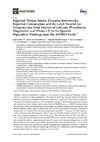Identificador persistente para citar o vincular este elemento:
https://accedacris.ulpgc.es/jspui/handle/10553/37104
| Título: | Reported dietary intake, disparity between the reported consumption and the level needed for adequacy and food sources of calcium, phosphorus, magnesium and vitamin D in the Spanish population: findings from the ANIBES Study | Autores/as: | Olza, Josune Aranceta-Bartrina, Javier González-Gross, Marcela Ortega, Rosa M. Serra-Majem, Lluis Varela-Moreiras, Gregorio Gil, Ángel |
Clasificación UNESCO: | 3206 Ciencias de la nutrición | Palabras clave: | ANIBES study Calcium Food intake Magnesium Misreporting, et al. |
Fecha de publicación: | 2017 | Publicación seriada: | Nutrients | Resumen: | Calcium, phosphorus, magnesium and vitamin D have important biological roles in the body, especially in bone metabolism. We aimed to study the reported intake, the disparity between the reported consumption and the level needed for adequacy and food sources of these four nutrients in the Spanish population. We assessed the reported intake for both, general population and plausible reporters. Results were extracted from the ANIBES survey, n = 2009. Three-day dietary reported intake data were obtained and misreporting was assessed according to the European Food Safety Authority (EFSA). Mean +/- SEM (range) total reported consumption of calcium, phosphorus, magnesium, and vitamin D for the whole population were 698 +/- 7 mg/day (71-2551 mg/day), 1176 +/- 8 mg/ day, (331-4429 mg/day), 222 +/- 2 mg/day (73-782 mg/day), and 4.4 +/- 0.1 mu g/day (0.0-74.2 mu g/day), respectively. In the whole group, 76% and 66%; 79% and 72%; and 94% and 93% of the population had reported intakes below 80% of the national and European recommended daily intakes for calcium, magnesium and vitamin D, respectively; these percentages were over 40% when the plausible reporters were analysed separately. The main food sources were milk and dairy products for calcium and phosphorus, cereals and grains for magnesium and fish for vitamin D. In conclusion, there is an important percentage of the Spanish ANIBES population not meeting the recommended intakes for calcium, magnesium and vitamin D. | URI: | https://accedacris.ulpgc.es/handle/10553/37104 | ISSN: | 2072-6643 | DOI: | 10.3390/nu9020168 | Fuente: | Nutrients [ISSN 2072-6643], v. 9 (2), article number 168 |
| Colección: | Artículos |
Citas SCOPUSTM
118
actualizado el 08-jun-2025
Citas de WEB OF SCIENCETM
Citations
99
actualizado el 08-jun-2025
Visitas
106
actualizado el 24-ago-2024
Descargas
136
actualizado el 24-ago-2024
Google ScholarTM
Verifica
Altmetric
Comparte
Exporta metadatos
Los elementos en ULPGC accedaCRIS están protegidos por derechos de autor con todos los derechos reservados, a menos que se indique lo contrario.
